Chicken Curry with Fresh Coconut Milk
When I was a kid living in Ft Lauderdale and Miami, we had graceful, sweeping coconut palms on the beach. They were the palms of South Pacific and Gilligan's Island -- exotic, beautiful, and always ready to brain someone walking underneath. Unfortunately, the coconut palms in South Florida and the Keys got hit with a blight in the 70s, and they all died out. These days, another variety of coconut palm grows in Florida, blight-resistant and just as bountiful, but they are short, squat trees that grow straight up with no arc or sweeping curve.
The last couple years I lived in Atlanta, I knew I'd move back to Florida some day, and there were two things I wanted: a fishing boat, and a coconut palm.
I got the fishing boat fairly quickly, but the first place I lived had no coconut palm. A coconut did wash up under my dock after a storm, so I planted it for fun (it may take a year for one to sprout), but it never grew. These days, we live in a house with two coconut palms in our yard, (the boat is another story -- my first got swamped and destroyed by Hurricane Jeanne, and I'm currently rebuilding a project boat for fun).
We live at the northern limit for coconut palm growth. They won't take a freeze, or even a frost, and our trees probably wouldn't survive inland a couple miles. It takes a palm just about a year to mature a coconut, which seems like a long time, except that the palm will flower and grow another cluster about once a month, so there's always a rotating bounty of nuts. When we first moved a little over a year ago, there were no nuts on the tree, someone had cleared them off. So now, we are harvesting our first ripe coconuts since we've moved in.
The coconut milk found in cans, commonly used in curries, comes from a process of extracting the liquid fat from the coconut meat found inside. I've always wanted to try to do this, and with a bunch of harvested nuts, I figured I'd give it a try.
I made a green curry chicken with sprouts, mushrooms, bamboo shoots, garlic, and scallions, and served it over pad thai noodles.

The tree:

When we were kids, in between body surfing, we'd pick up beach rocks and driftwood and hammer away at coconuts all day until we got one from it's husk. It's not an easy task. There's a bit of a trick to splitting the husk without smashing through the nut itself. This time, I used the back of a claw hammer, but I choked up on it a lot so I could be a little more precise where I was hitting, and thus dig into the husk and not my own fingers or toes. There are some natural "lobes" to the husk, and by chopping through the thin parts, the lobes will separate with a bit of persuasion.
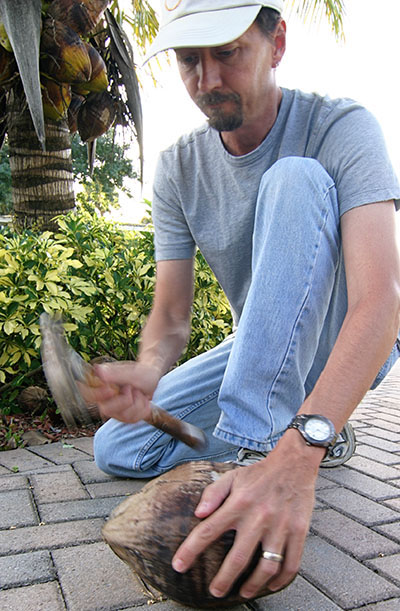

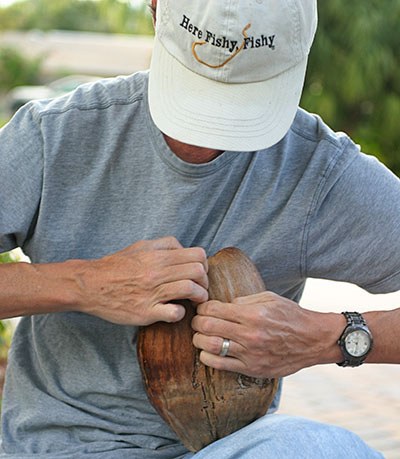

Once the nut is freed from the husk, a series of gentle taps with the claw on the nut will create a fracture line. Spin the nut and tap, and it'll crack in half, a few inches at a time.
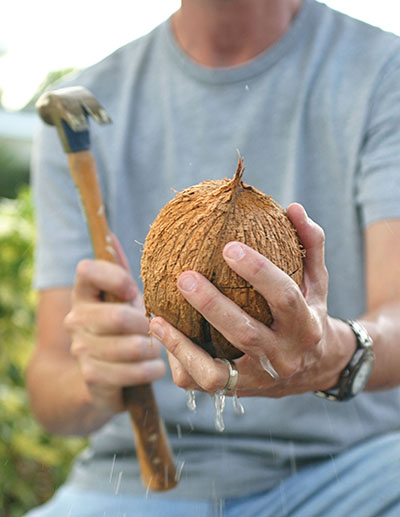
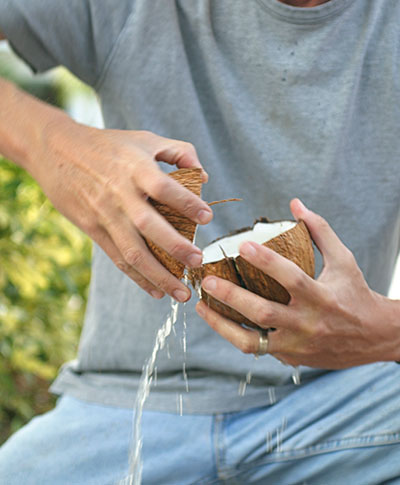
The liquid inside, as many shipwrecked sailors know, is tasty. Due to the way the nut is formed, it's also sterile and a little pressurized -- during WWII, doctors in the Pacific would use green coconut water as IV fluid in a pinch in on-site surgical hospitals. The water is clear, though, and is not what is called coconut milk or coconut cream. My stepsons wanted to give it a try:

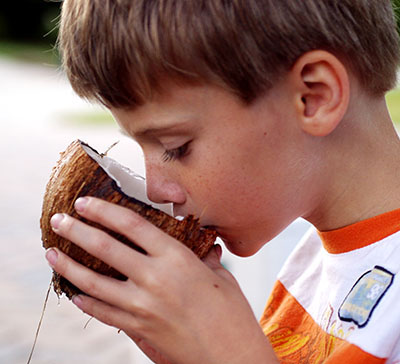
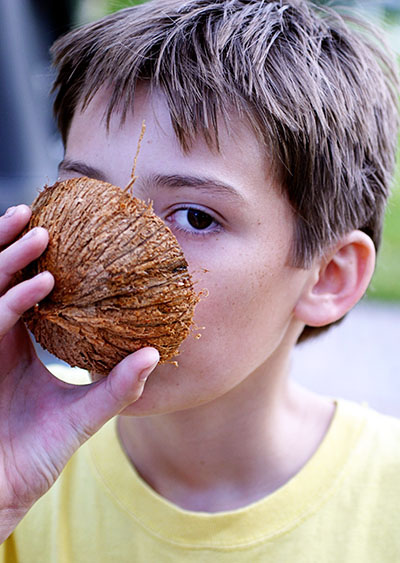
I took the halves of two coconuts and baked them in a 350 degree oven for about 15 minutes. This was supposed to make the meat a little softer, and easier to remove from the shell.


Did it work? Well, if that was considered "more loose", then I'm glad I didn't try without baking first. The meat did come out, but some brown papery husk was still attached. Many will skip this step and just scrape out the meat, and there are tools for it, but my arms were already sore from dehusking the things, so I went for the low-effort approach. The brown skin was easily removed with a potato peeler.

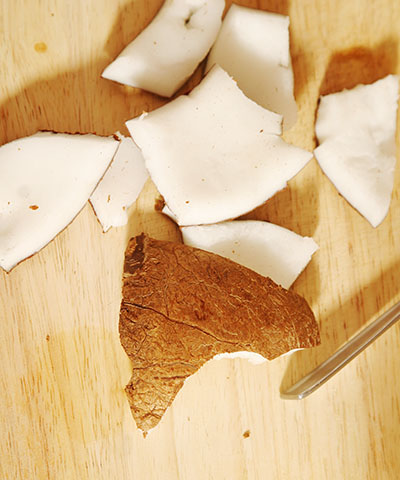
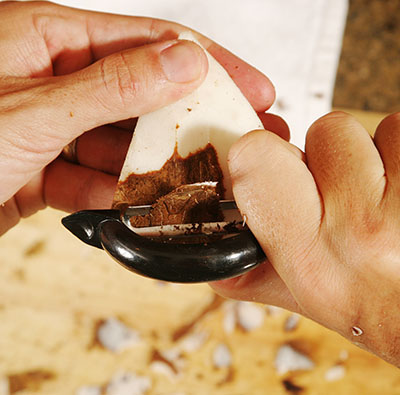
I chopped the coconut into chunks and strips and tossed a couple cups of meat in the food processor with the same amount of water (I've heard some people use coconut water for this, but ours was gone by this point). The coconut meat was pulsed many times to get it down to a snow-like consistency.
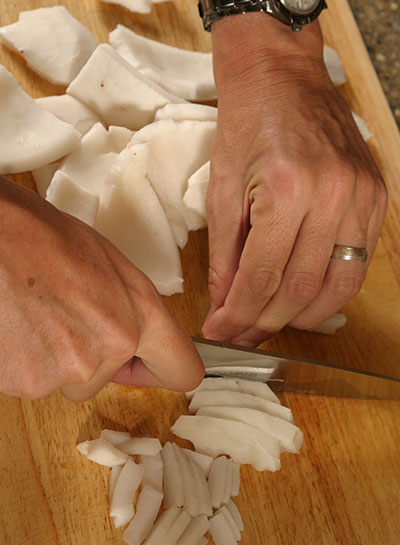
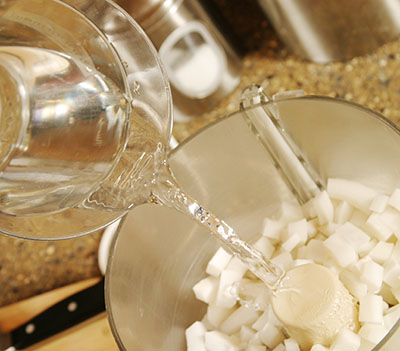

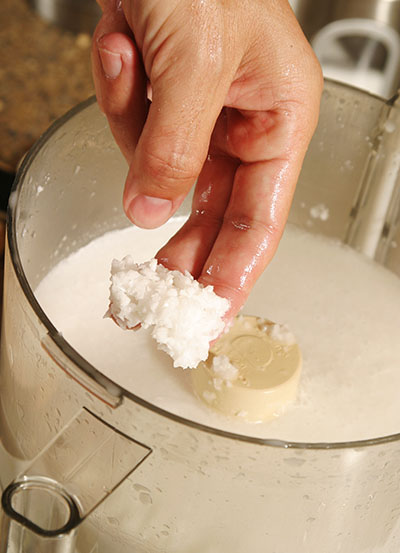
I lined a bowl with a very clean dishtowel, poured the bowl of mixture into it, then closed it and did a lot of squeezing into the bowl.
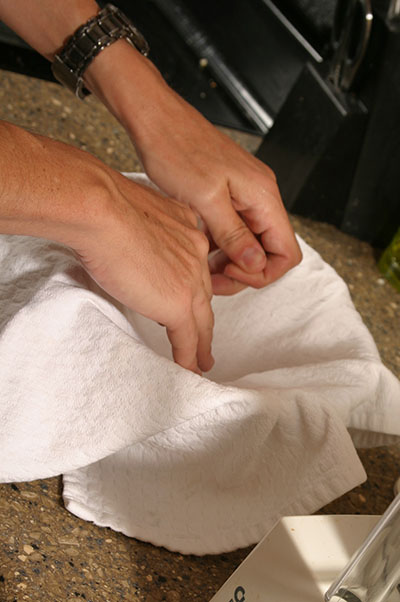
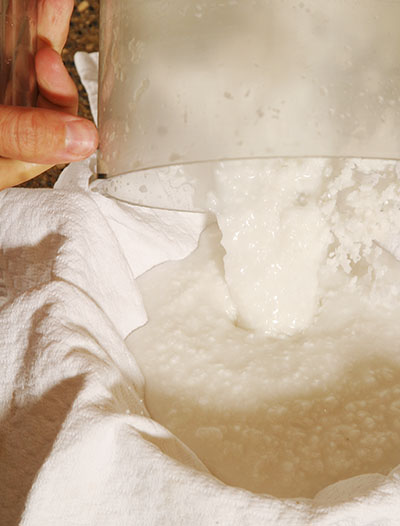
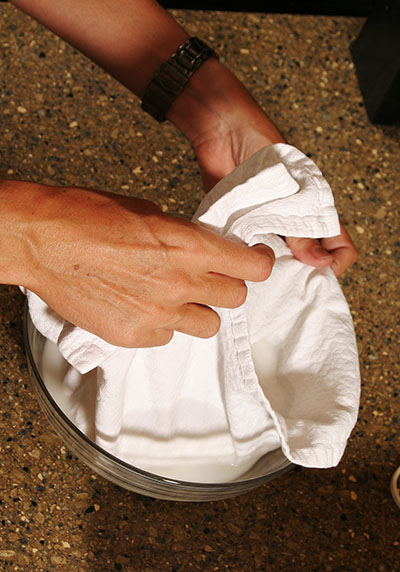
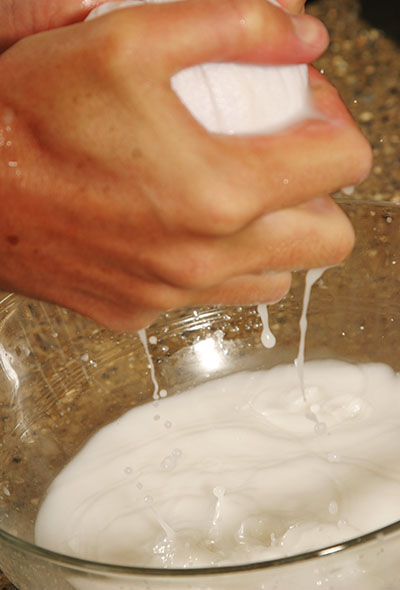
This is what is considered the "first pressing" (or squeezing), and will generate a lot of coconut "cream", or the mixture containing the most coconut fat. Some jokingly call it "extra virgin" coconut milk. You can repeat this a couple times with more water, and it will get less and less rich. I got about 2 cups of milk/cream mixture, which did separate when I kept it on the counter for a while. I mixed it back up again, though, and froze a cup for future use, while refrigerating a cup for later use in the curry.
To start the curry, I minced a garlic clove, sliced a couple scallions, and chopped a mushroom. I put a 12-inch skillet on medium-high, and after it heated, added a couple tablespoons of olive oil and sauteed the garlic and scallions.
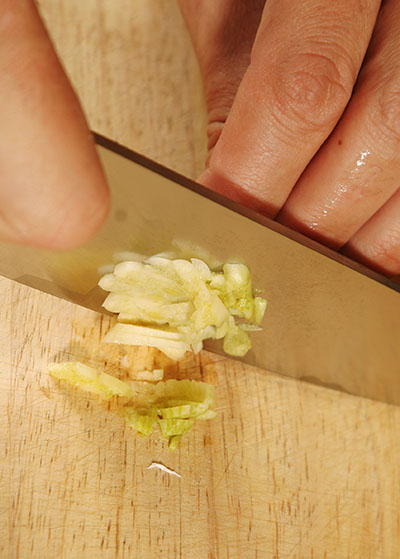
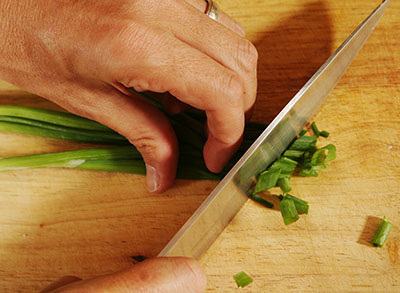
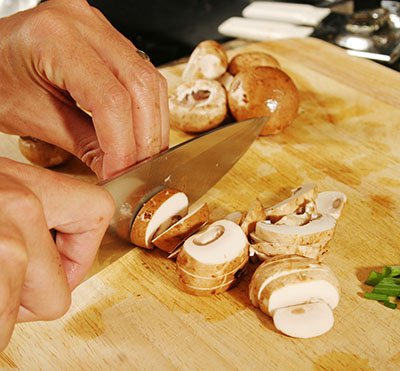
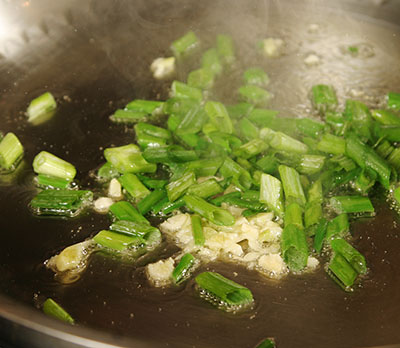
I added sliced water chestnuts, then added the bamboo shoots and mushrooms.
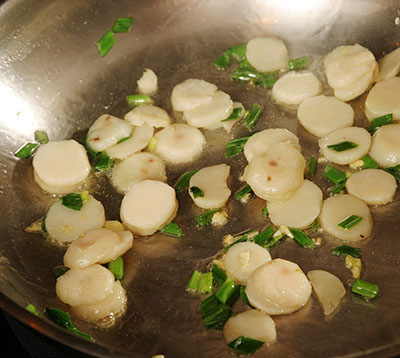

Meanwhile, I cut a chicken breast into thin strips and sauteed for a bit on the outside in a separate pan.
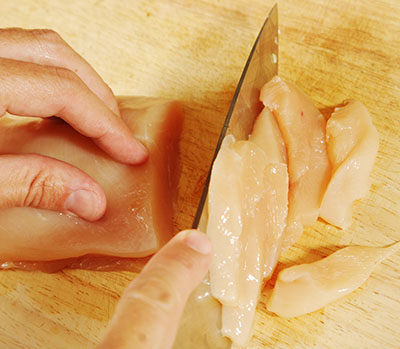
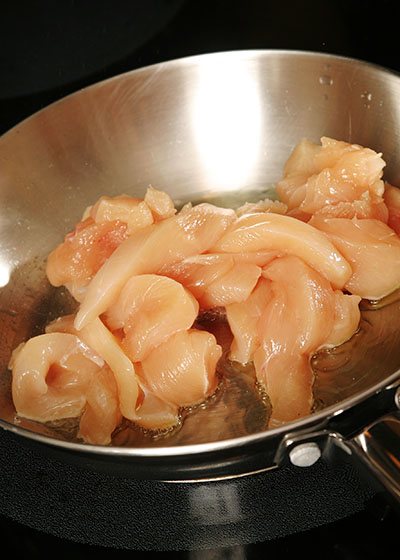
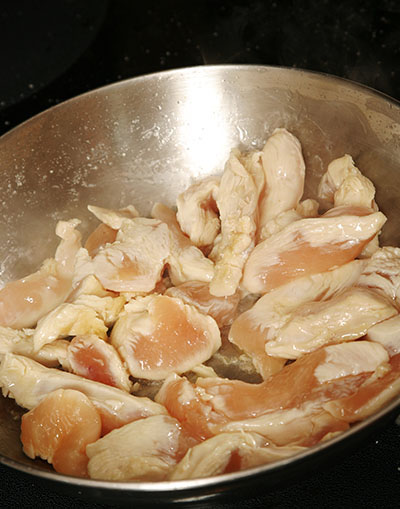
I added green curry paste to the vegetables, then the cup of coconut milk and 1/2 cup of chicken stock.

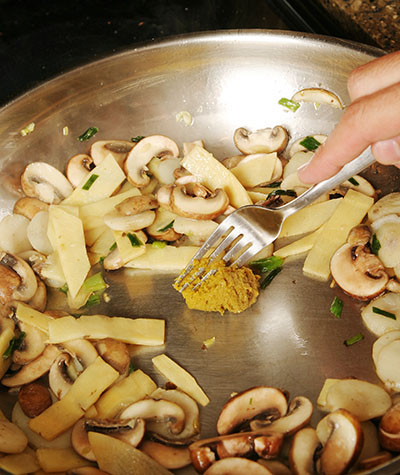

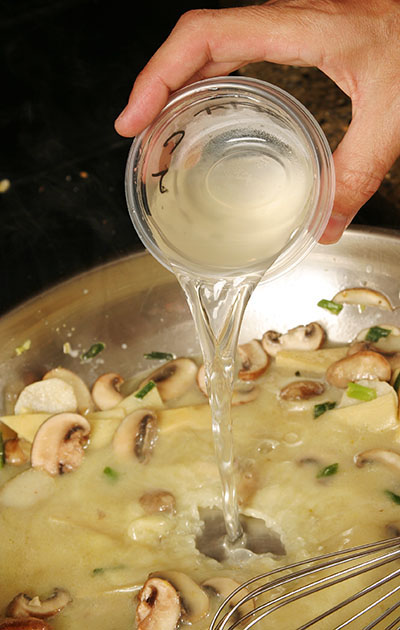
I let this reduce by 1/2 to 2/3rds at a nice simmer. I wanted a thick sauce to coat everything nicely. Once reduced, I added the chicken and bean sprouts and simmered lightly only for 4-5 minutes, until the chicken was reheated and cooked in the center.

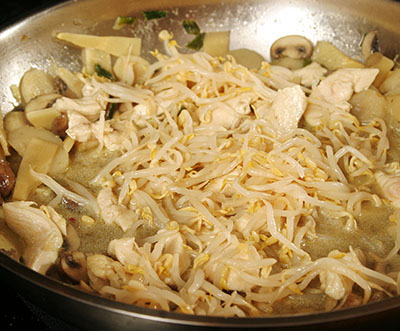
I already had a pot of water boiling, and as the chicken warmed and cooked slowly, it was just enough time for the rice noodles to cook.
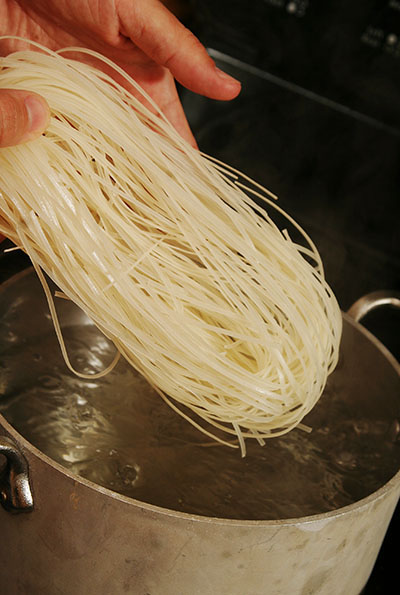
At the end, I added the juice of a lemon to the curry, then served it over the noodles.
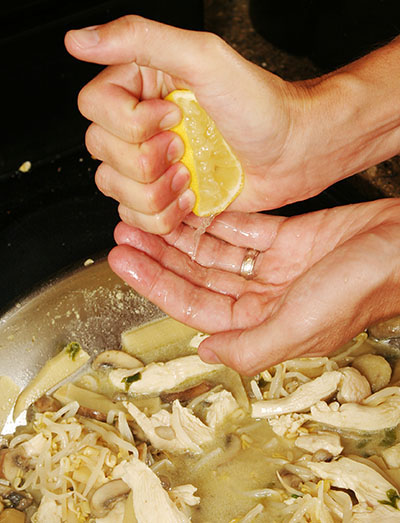
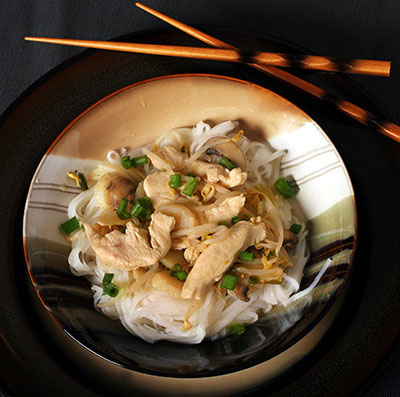

Deconstruction: I kinda did the reverse curry. I know people who make their own green curry paste, yet used canned coconut milk. I did the opposite. For a first try, this wasn't bad. The taste was definitely there -- a very subtle (yet present) fresh coconut taste, pervading the meal. Very tropical. I needed a touch more curry paste. It's very hard to judge, and a bit either way is the difference between a very mild curry and "bring a handkerchief to mop your forehead". My tastes lean toward the latter, but this dish leaned toward the former.
The coconut milk was too runny, alas. I knew when I saw it in the bowl that it was definitely more watery than the thick stuff out of the can. The stuff floating on top was more the correct consistency. I think if I added near-boiling water instead of cold water to the food processor, then let it sit a little longer, it might have worked. And, I could have done a couple squeezings, then skimmed the top for what I wanted. I tried to reduce it a lot, but it was tough doing it in the same pan as the vegetables, because I didn't want them to overcook -- a bit of a paradox.
Still, it was a nice tasting meal, and definitely something to try again with the zillions of coconuts I'm getting from this tree. And it was a lot of fun!



